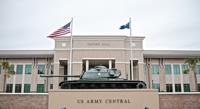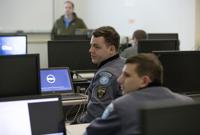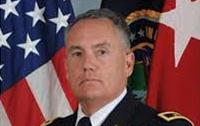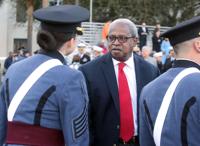One of the Army's most historic commands has been making crucial military decisions in the War on Terror, the fight against the Islamic State and counterterrorism in the Middle East for the past decade, right from the heart of South Carolina.
The 3rd Army, known today as U.S. Army Central, has been on the front lines of history. Their first mission was to cross the Rhine in the final days of World War I. They rolled back Nazi forces in World War II. Their deployment during Operation Desert Storm was a brutal blow to the Iraqi Revolutionary Guard.
Since 2011, they've had their boots in the Palmetto State soil. When Fort McPherson in Georgia closed due to a Base Realignment and Closure Act issued in 2005, the storied command's headquarters was brought to Sumter, on the grounds of Shaw Air Force Base. They organize the strategy to take on terrorists and hostile governments in the Middle East.
"We direct all those operations that are going on in the Middle East right here in South Carolina," said Mike Clauss, the historian for Army Central. "We're protecting our nation right here from Sumter by deciding where we are deploying our military forces."
In a 4-million-square-mile region involving 20 Middle Eastern countries, Army Central coordinates the logistics and strategy of a fighting force of nearly 24,000 soldiers, civilians and contractors.

The American and South Carolina flags fly over Patton Hall, home of U.S. Army Central, where an old M48 series “Patton Tank” is prominently displayed. It was the third tank to be officially named after Gen. George S. Patton, commander of the U.S. Third Army during World War II and one of the earliest American advocates for the use of tanks in battle. Sgt. Victor Everhart/U.S. Army Central.
But specifically and most recently, Army Central has overseen Middle East strategy for the past 20-plus years. It had a major role in Kuwait during Operations Desert Shield and Storm, as well as Afghanistan and Iraq during Operations Enduring Freedom and Iraqi Freedom.
And the fight continues to this day, with Army units being directed in South Carolina offering training to forces in the Middle East against terrorist insurgents.
From forts to the front lines
Army Central's history is one of stop and go.
Less than a week before the end of World War I, the 3rd Army was activated by Maj. Gen. Joseph Dinkman with orders to Germany. When the country said it intended to sign the Treaty of Versailles, the unit was deactivated.
In 1932, the 3rd Army was reactivated at Fort Sam Houston in Texas, serving as the largest training attachment for the branch. A little more than a decade later, those soldiers were put to task. The unit was reactivated during the outbreak of World War II.
"Third Army was responsible for training all the forces throughout the Southeast, from Texas to the Carolinas," Clauss said. "But then the storm clouds were brewing in Europe."
On New Years’ Eve 1943, the 3rd Army was told to prepare for overseas movement to the United Kingdom for participation in the European invasion. When the men landed, they were assigned a new leader: Gen. George S. Patton.
Patton had been fictitiously leading the 1st Army Group, a pump fake to the Nazis to lead them off the scent of where the allied invasion of France would take place. In July 1944, the 3rd Army headquarters landed in France and began to steamroll through the region.
After multiple conflicts, including the Battle of the Bulge, the unit forced a Nazi surrender. During the war, 3rd Army had nearly 17,000 soldiers killed to more than 1 million enemy casualties. The unit's headquarters in Sumter is named Patton Hall in the general's honor.

Lt. Gen. Terry Ferrell, U.S. Army Central commanding general, answers questions at a community leader orientation inside the Operation Center at Patton Hall on Sumter's Shaw Air Force Base, Oct. 2, 2019. Staff Sgt. Matt Britton/U.S. Army
Third Army was subsequently deactivated again and assumed a training role, this time at Fort McPherson near Atlanta. The unit wouldn't return to combat again until 1990 during Desert Storm. Since then, it has been involved in taking on emerging terrorist groups in a post-9/11 world.
Taking on terror
Army Central has administrative control over all of the Army's forces in the Middle East and Central Asia which includes "supplying, equipping, training, servicing administrating and maintaining" overseas forces, according to its website.
But in times of intense conflict and disaster, the South Carolina-based command also serves as the head of a joint task force, where other branches are looped in to tackle larger operations. In 2003, during the invasion of Iraq, Army Central collaborated with several branches. It happened again in 2014 and 2015 when the Department of Defense prioritized eradicating Islamic State terrorists.
And while little is known of what specific military operations Army Central is involved in at any given time, some of its units' missions and initiatives are publicized through the Army's public affairs office.
In February, under Army Central's command, the Army's 3rd Security Forces Assistance Brigade began partnering with the Kurdish Peshmerga.
The volunteer military force faces a constant onslaught of violence from IS terrorists in the Makmuhr mountains of Northern Iraq. IS fighters killed and attacked shepherds in their town. The Army was called in to offer support.
“ISIS is very dangerous because we think they’re coming back,” Maj. Ihason Zebari with the Peshmerga told the Army. “They’re making a comeback. We are and we have been fighting against ISIS on behalf of the whole world. But we are also fighting with the help of the Americans, and we want that help to continue.”
But in addition to the threat of gunfire, large amounts of improvised explosive devices — some placed by terrorist groups and others still in place from Iran-Iraq War — still litter the region. The Army command is teaching the Peshmerga how to safely detonate the devices to make the town safer.
“They are also very friendly to us,” Sgt. 1st Class Joseph Duehning said about the mission. “They wouldn’t, I say, consider the Americans heroes. But kind of, almost. That’s why all the people on the street when you pass by are smiling and waving.”
2020-03-01 21:02:22Z
https://www.postandcourier.com/militarydigest/the-army-s-strategy-to-defeat-middle-east-terrorists-is/article_55357b66-580e-11ea-9f20-87be58ea58bc.html
Read Next >>>>
Bagikan Berita Ini

















0 Response to "The Army's strategy to defeat Middle East terrorists is decided at this SC headquarters - Charleston Post Courier"
Post a Comment